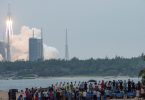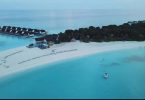Freshwater resources throughout tropical islands are endangered by saltwater intrusion due to extreme storm events. But the Maldives are uniquely vulnerable, research shows.
This research paper was produced for the Water Resources and Climate course taught by Dr Indrani Pal at the Sustainability Management graduate program at Columbia University.
Introduction
Islands such as the Maldives in the Indian Ocean are especially sensitive to sea level and sea surface temperature rise brought on by man-induced climate change. They are a warning to the rest of the world that it is imperative that there are major changes in the way that humans use energy and natural resources in order to sustain life on Earth. This article seeks to establish the reasons for this vulnerability and to understand the ways that the hydrology of these coastal islands will be affected by global warming.
This was done through an examination of current research articles published on how the archipelago’s water availability will be altered by climate change and summarizing their findings. Virtually all of the current research shows that freshwater resources throughout the Maldives are endangered by saltwater intrusion due to extreme storm events and that adaption must happen in order to provide the local population with adequate drinking water.
“Soft” infrastructure improvements such as ecosystem restoration of mangroves and corals were generally recommended over “hard” infrastructure projects like sea wall construction. Although a fund has been established by the Maldivian government which will provide millions of dollars for these types of measures, it is imperative that political will be shifted towards an urgency of climate change adaptation. This is the only way that communities in the Maldives will be able to protect their home.
“We must unite in a world war effort to halt further temperature rises. Climate change is happening and it threatens the rights and security of everyone on Earth. We have to have a better deal. We should be able to come out with an amicable understanding that everyone survives. If Maldives can’t be saved today, we do not feel that there is much of a chance for the rest of the world.” [Statement by the Maldivian cabinet members during their 2009 underwater meeting on climate change] (Hirsch 2015)
Research into the anthropogenic warming of Earth’s climate has found that climate change will have a significant effect on future water resources worldwide. Tropical coastal ecosystems will be particularly vulnerable to the threat of climate change and will experience more frequent and higher intensity occurrences of drought, floods, tropical cyclone activity, sea surface warming, ocean acidification, and extreme sea-level rise (Hernández- Delgado 2015). All of these events are projected to have an impact on the availability of water resources and will also alter substantial elements of public health, local economic growth, food security, and biodiversity in these tropical island communities.
This paper will focus on the Maldives, an island nation located in the Indian Ocean, some 300 miles from India. The five different sections will detail general characteristics of tropical islands’ hydrological cycles, the various ways in which they are susceptible to sea-level rise, how these changes will affect the water resources for the island, and the adaptation measures that their government is taking in response to these challenges. The paper will conclude with recommendations for strategies that the Maldives can pursue in order to reduce the risks brought by climate change and help protect the people living there.

SECTION ONE: Hydrological Systems in Tropical Island Ecosystems
The amount and frequency of rain in the tropics is due mostly to Hadley cells converging in the intertropical convergence zone, commonly called the ITCZ, the location of which is determined in large part to ocean currents. Warming of the sea surface temperature (SST) brought on by climate change is anticipated to change these patterns, leading to less overall rainfall but higher occurrences of extreme precipitation. The El Niño southern oscillation (ENSO) will also become more frequent and last for a longer duration, with more drought and flood events as a result. These changes in the hydrological cycle will produce alterations to infiltration rates, potential evapotranspiration, and surface runoff. All of the aforementioned processes will have a substantial effect on freshwater availability (Strauch et al 2015).
This projected decline in rainfall will have other consequences as well: the productivity of estuaries is expected to be affected adversely due to alterations in nutrient and sediment delivery rates. Saltwater intrusion is likely to occur as a result of declining aquifer recharge, which will be exacerbated by sea-level rise as well. This is a problem that is made more complicated for islands like the Maldives, as population growth and migration to cities increase the demand for water resources (Hernández- Delgado 2015).
Fluctuations in streamflow is another aspect that is altered by these changes in rainfall. Understanding this relationship is necessary in order to properly plan for water infrastructure through the development and design of culverts, bridges, and stream crossings. Streamflow also plays an important role in the evolution of freshwater organisms. While there have been many models created to analyze and predict the response of streamflow to changing climatic conditions, the lack of basic information available for tropical island ecosystems makes it difficult to do so with accuracy. Of course, the paradox is that these regions are where this information will be needed most in order to make decisions (Strauch et al 2015).
SECTION TWO: The Maldives, A Climate Change “Synecdoche”
There are many reasons why the Maldives are especially prone to the effects of rising temperatures and sea-level rise. These tie into the concept of the island as a synecdoche, a place that is uniquely vulnerable to the effects of climate change and therefore a “canary in the coalmine” for global warming as a whole. One of the more certain consequences of climate change is a minimum of 1-meter sea-level rise. (Hirsch 2015).
The Maldives is an archipelago, comprised of 1,192 islands that are on average only 1.5 meters above sea level. It is considered to be the lowest nation in the world; many of the islands are just sandbars that are only visible during certain tide cycles, which is why locals sometimes call it woden adhi girun, which means “the nation of appearances and disappearances” (Sovacool 2012).
For thirty years, the Maldives existed as an authoritarian dictatorship under President Maumoon Gayoom. In 2018, they appointed their first-ever democratically elected leader Mohamed Nasheed, who placed climate change as his first priority for the new government. Nasheed declared at the time, “It won’t be any good to have a democracy if we don’t have a country,” stressing the importance of sea-level rise above all other concerns. Shortly after, the president made international headlines by holding an underwater cabinet meeting while dressed in scuba gear, signing a declaration that urged world leaders to commit to greenhouse gas reductions at the upcoming Copenhagen climate conference. Nasheed committed to making his nation carbon-neutral in order to set an example for countries with larger influence and emissions to pursue aggressive goals to try to reduce the amount of carbon in the atmosphere to the desired 350 parts per million that scientists have recommended (Hirsch 2015).
Sea level rise is a major concern for the inhabitants of the islands, as storm surges can lead to the inundation of the land. Almost half of the people living in the Maldives are located within 100 meters of the shoreline, and most critical infrastructure like airports, airports, and power plants are also near the shore. As a government official explained in one research article,
“Geographic and geophysical constraints force communities here to live close to the sea. The scarcity of land in the Maldives, the smallness of the islands, and extreme low elevation makes retreat inland or to higher ground impossible” (Sovacool 2012).
Moreover, the economy is largely dependent on fishing and tourism, which is almost entirely based around coastal-related activities. It is clear that the livelihood of the Maldivians is at risk due to the rising seas. Many homes throughout the islands will have to be evacuated, fish will be scarcer, and tourist endeavours such as coral reef diving will become less lucrative as habitats dwindle.
In December 2004, a tsunami from the Indian Ocean demonstrated the destruction that the Maldives can encounter from extreme weather events. Almost all of the islands were submerged completely for several hours. Six of these islands were rendered irreversibly uninhabitable and the economic damage was immense for the Maldives, with a loss of over 60 per cent of the country’s GDP (Nicholls 2006). These types of events also have a substantial impact on the islands’ available water resources.
SECTION THREE: Water Resources for the Archipelago
The Maldives consist of atolls, which are rings of coral reefs that make up the islands. The people living there have three natural sources of drinking water: a shallow aquifer beneath the soil on some of the islands, groundwater, and rain catchment. There is also some desalination, but this is only used at tourist resorts at a high cost. Flooding puts aquifers and groundwater at risk of saltwater intrusion, and catchment is also less viable due to declining rates of precipitation (Sovacool 2012).
Most of the water that is used by the Maldivians comes from groundwater resources, about ten times more than from rain catchment systems. These resources are fragile as a result of low elevation — which increases the likelihood of contamination — and the relative thinness of the freshwater lens (Deng 2017). The lens, in hydrological terms, is a layer of fresh groundwater that floats on top of saltwater below. These are typically found in atolls and are recharged through the infiltration of rainwater percolating through the soil. The recharge rate of these lenses can be understood through the equation R= P-ET, where R is the recharge rate in meters, P is precipitation, and ET is the evapotranspiration of water. The higher the recharge rate, the thicker the lens will be in these groundwater aquifers (Bailey 2008).

Sea level rise can lead to a partial or complete depletion of the lens thickness of these freshwater resources, especially on smaller islands where the majority of the population lives (Deng 2017). These marine overwash events are some of the most significant threats to island groundwater aquifers, but the lens can also be diminished by mining, variable rainfall patterns, and shoreline recession. Subsequent recharge happens slowly, and the freshwater lens can take up to 1–3 years to fully recover from salinization.
It is important for the governmental leaders of the Maldives to understand these hydrological processes when making water management decisions after inundation events (Alsumaiei 2018).
SECTION FOUR: Adaptation Strategies
The Maldivian government has recognized the need for adaptation in order for the island to prepare for the instability that climate change will inevitably bring to their water supply. In one interview, a senior official stated, “We have no choice but to adapt to climate change. For us it is not a matter of development or balancing adaptation with economic growth; it is out of necessity and a matter of national survival.” They have taken several measures accordingly in recent years to address climate change (Sovacool 2012).
The “Integrating Climate Change Risks into Resilient Island Planning in the Maldives” program, or ICCR, is a four-year plan that includes over $9 million for adaptation measures. The program is focused on “soft” infrastructure, which are measures that work with existing ecosystem services. This is different from “hard” infrastructure like the construction of sea walls, which are more cost-intensive and can be counterproductive as well. Building sea walls — which have been offered by many political leaders as the answer to impeding storm surges — can cause nutrient flows to shift, which harms coral reefs (Sovacool 2012).
These projects can be extremely expensive: the sea wall around Malé, the biggest city in the Maldives, cost $54 million to construct and covers less than 5 kilometres of coastline. With $9 million to spend for the ICCR fund, they need to concentrate on more efficient means of protection. Replanting of mangroves is a good example of a “soft” infrastructure that restores the natural ecosystem while providing protection against storms and saltwater intrusion. Discontinuing practices that further weaken the island’s defences should be emphasized as well. Vegetation has been removed for resort construction which would otherwise provide a buffer against inundation, and the mining of sand and corals are similarly harmful and accelerate coastal erosion. Changing these practices will go a long way to protect their shorelines.

The ICCR is providing funding to projects that demonstrate the efficacy of these types of remediation, through different measures on islands across the Maldives.
1) On Kulhudufushi, there is restoration planned for natural ridges, coastal forests, and the island’s drainage system.
2) A project on Thulusdhoo will repair breaches in the coral reef sea wall.
3) Vegetation will be restored on Thinadhoo, and mangroves on Kudhahuvadhoo will be planted as a means of protecting the shoreline against sea swells (Sovacool 2012).
These types of “soft” infrastructure projects should be pursued further, as they work to use the environment the way it was originally intended and are a better use of funding than the “hard” measures such as sea wall construction and desalination of water listed in the table in Figure 3.
SECTION FIVE: Conclusions
There are many obstacles for the Maldives to overcome, and there is no certainty that they will survive, even if they do everything they should. However, it is possible that they can weather the storm through adaptation to climate change. In order to do so, their political leaders have to place this adaptation as a priority for their agendas going forward. Sea levels and global temperatures will continue to rise for the foreseeable future, and coastal islands like the Maldives will feel the effects of these more acutely than any other place on Earth. Not only should island nations continue to demand commitments of mitigation from the world’s biggest polluters, but they will benefit by continuing to invest in scientific studies that help to understand the connection between climate change and natural resources.
The changing climate not only affects sea level rise but rates in precipitation and temperature, which in turn leads to diminished availability of water and destroys coral reefs. Policymakers can often overlook these concerns because of more near-term problems. One interview with local leaders put it succinctly:
“Climate change has to compete with other priorities, things like unemployment, drugs, tourism, civil service, and corruption.” (Sovacool 2012).
There is a possibility that if the Maldives’ leadership does not put climate change adaption first that these issues cease to exist and will be swept away with the rest of the island. It is their responsibility to prepare for these changes and act before this is reality.
Full details are available at the link below:
Source URL: Medium







